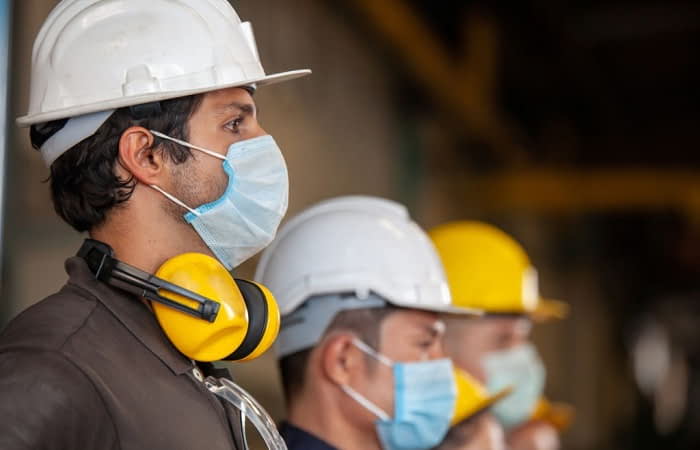Air Quality Testing

At ADE, we offer an extensive range of air quality testing and air monitoring services for a wide range of clients and situations including for the workplace, hazard exposures and environmental.
Our Environmental Consultants and Occupational Hygienists (based in Sydney, Newcastle, Brisbane and Melbourne) perform investigations tailored specifically to each client’s needs – ranging from a preliminary survey through to detailed Employee Exposure Assessments, which can determine potential exposure to certain elements such as indoor air quality, noise levels, exposure to chemicals, asbestos etc. Our team will recommend engineering controls, personal protective equipment (PPE) or remedial action as necessary.
All ADE reports issued include advice and recommendations on whether environmental and/or contract standards are met and if any remedial actions are required.
Indoor Air Quality Testing
ADE Consulting Group have extensive experience in testing the air quality inside buildings. There are six key air pollutants to which most Australians are exposed to, these being carbon monoxide, ozone, sulphur dioxide, nitrogen dioxide, lead and particles. The exposure levels for these pollutants were determined by the Air NEPM (National Environment Protection Measurement for Ambient Air Quality) standards recommended by the National Environmental Protection Council (NEPC) in 1998 to be legally binding and enforced by the year 2008. In addition to the six key air pollutants, ADE Consulting Group can provide monitoring for Air Toxics, these being benzene; formaldehyde; benzo(a)pyrene as a marker for Polycyclic Aromatic Hydrocarbons; toluene; and xylenes.
The Indoor Air Quality Parameters monitored in our tests are:
- Carbon dioxide (CO2)
- Carbon monoxide (CO)
- Nitrix oxide (NO)
- Nitrogen Dioxide (NO2)
- Inspirable and respirable dust
- Metals in Dust
- Volatile organic compounds (VOCs)
- Formaldehyde
- Asbestos
- Diesel Particulate Matter
- Ozone
- Temperature, Humidity, Wind speed
In addition to the above, a chimney emissions test is available, which monitors the type and concentration of emission gas streams from chimney stacks or other designated emission points. Typically this would test for:
- Total Suspended Particulates (TSP);
- Sulphur Oxides (SOx);
- Nitrogen Oxides (NOx);
- Chlorides and Fluorides;
- Polycyclic Aromatic Components;
- Dioxins
Dust Monitoring
There are many different types of dust that can cause adverse health effects. Inhalable dust and respirable dust will be present in most workplaces – particularly in outdoor environments. Exposure to dust of respirable size presents a chronic health risk and can lead to a range of lung diseases.
Inhalable and Respirable Dust
To obtain a representative personal sample, the dust monitoring equipment is to be worn for at least 6-12 hours. Static (area) sampling can also be completed on your site should this be required. ADE Consulting Group Staff will be present during the monitoring periods to observe the tasks being performed.
Sampling for Inhalable dusts will be undertaken in accordance with AS 3640-2009: Workplace atmospheres—Method for sampling and gravimetric determination of inhalable dust. Sampling for Respirable dusts will be undertaken in accordance with AS 2985-2009: Workplace atmospheres—Method for sampling and gravimetric determination of respirable dust.
The dust samples will be assessed by a NATA accredited laboratory via gravimetric analysis. We use a NATA accredited external laboratories analysis of any contaminants outside our NATA accreditation and provide detailed hygiene monitoring reports which outlines the results, conclusions, and recommendations from the monitoring. ADE also provides copies of the NATA accredited laboratory reports and personalised employee feedback letters.
Respirable Crystalline Silica
Testing respirable dust includes mineral dusts such as Respirable Crystalline Silica (RCS) which are ubiquitous across the globe. RCS is one of the most common minerals crystalline/quartz) found on the planet. It is classed by IARC as Group 1 Carcinogenic to humans, as exposure to excessive Respirable Crystalline Silica (RCS) can lead to silicosis (progressive scaring/fibrosis of the lung).
Asbestos Fibres
A naturally occurring fibrous silicate mineral, asbestos can be broken down into two main categories: friable, and bonded asbestos. A mainstay material in Australia until the mid-1980s, Australia was one of the highest users per capita in the world and used asbestos across an array of products – the building industry amounting for one-third of this usage. With 90% of the world’s asbestos mined, asbestos is and remains a serious health risk.
Asbestos is a known cancer-causing agent; Asbestosis, Lung Cancer, and Mesothelioma are all causes of exposure to asbestos fibres. The fibres’ size, ability to split vertically into finer fibres, and their resistance to digestion within the body are the reasons behind their insidiousness. Find out more about our asbestos air monitoring services.
ADE will work alongside clients to establish and maintain protocols in dealing with asbestos hazards in the workplace. Maintaining strict systems and safety protocols, we make sure that you and your people abide by the necessary precautions for a safe and risk-free workplace.
Synthetic Mineral Fibres
Synthetic mineral fibres (SMF), also known as man-made mineral fibres (MMMF), is a collective term used for amorphous vitreous fibres such as glass fibre, rock wool, slag wool and refractory ceramic fibres (RCF).
Concerns that SMF will become the ‘new asbestos’ have not been substantiated by scientific studies. No form of SMF has been classified as being a confirmed human carcinogen, although some forms such as RCF are classified as being ‘possibly carcinogenic to humans. The new generation SMF that has low bio-persistence are not classified as carcinogens and are not considered hazardous substances. The main health effect is irritation to the upper airways and skin and eye irritation.
SMF can be adequately controlled by means of preferential use of the new generation of SMF, good ventilation practices and by maintaining a good standard of cleanliness and housekeeping.
A standard to limit exposure to no more than 2.0 mg of SMF in each cubic metre of air is recommended for the inhalable low-bio-persistent forms of SMF. A standard of 0.5 fibres in each millilitre of air should be used for some of the old forms of SMF such as RCF.
Enquiries
MARJETICA MCAULEY
State Health & Safety Lead (NSW)


